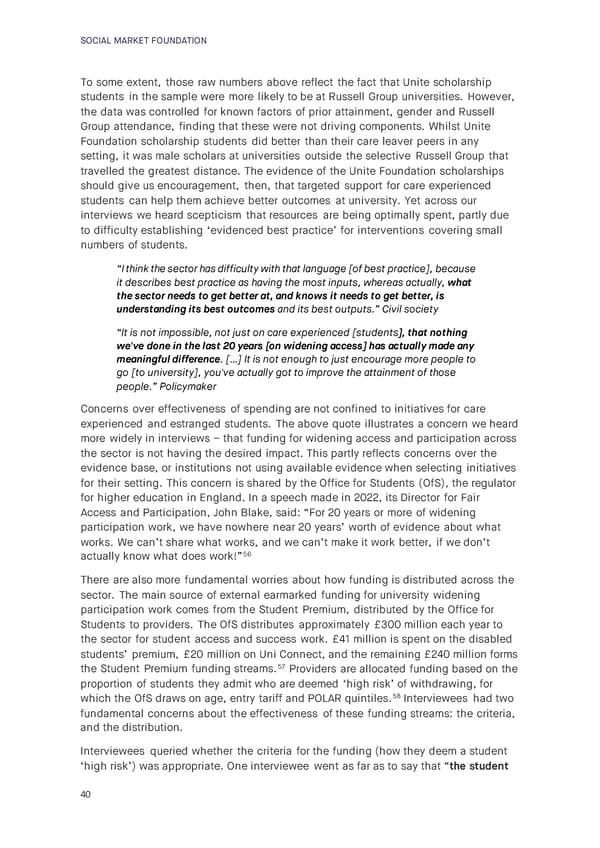SOCIAL MARKET FOUNDATION To some extent, those raw numbers above reflect the fact that Unite scholarship students in the sample were more likely to be at Russell Group universities. However, the data was controlled for known factors of prior attainment, gender and Russell Group attendance, finding that these were not driving components. Whilst Unite Foundation scholarship students did better than their care leaver peers in any setting, it was male scholars at universities outside the selective Russell Group that travelled the greatest distance. The evidence of the Unite Foundation scholarships should give us encouragement, then, that targeted support for care experienced students can help them achieve better outcomes at university. Yet across our interviews we heard scepticism that resources are being optimally spent, partly due to difficulty establishing ‘evidenced best practice’ for interventions covering small numbers of students. “I think the sector has difficulty with that language [of best practice], because it describes best practice as having the most inputs, whereas actually, what the sector needs to get better at, and knows it needs to get better, is understanding its best outcomes and its best outputs.” Civil society “It is not impossible, not just on care experienced [students], that nothing we've done in the last 20 years [on widening access] has actually made any meaningful difference. […] It is not enough to just encourage more people to go [to university], you've actually got to improve the attainment of those people.” Policymaker Concerns over effectiveness of spending are not confined to initiatives for care experienced and estranged students. The above quote illustrates a concern we heard more widely in interviews – that funding for widening access and participation across the sector is not having the desired impact. This partly reflects concerns over the evidence base, or institutions not using available evidence when selecting initiatives for their setting. This concern is shared by the Office for Students (OfS), the regulator for higher education in England. In a speech made in 2022, its Director for Fair Access and Participation, John Blake, said: “For 20 years or more of widening participation work, we have nowhere near 20 years’ worth of evidence about what works. We can’t share what works, and we can’t make it work better, if we don’t actually know what does work!”56 There are also more fundamental worries about how funding is distributed across the sector. The main source of external earmarked funding for university widening participation work comes from the Student Premium, distributed by the Office for Students to providers. The OfS distributes approximately £300 million each year to the sector for student access and success work. £41 million is spent on the disabled students’ premium, £20 million on Uni Connect, and the remaining £240 million forms the Student Premium funding streams.57 Providers are allocated funding based on the proportion of students they admit who are deemed ‘high risk’ of withdrawing, for which the OfS draws on age, entry tariff and POLAR quintiles.58 Interviewees had two fundamental concerns about the effectiveness of these funding streams: the criteria, and the distribution. Interviewees queried whether the criteria for the funding (how they deem a student ‘high risk’) was appropriate. One interviewee went as far as to say that “the student 40
 Care and Learning in Higher Education Page 40 Page 42
Care and Learning in Higher Education Page 40 Page 42